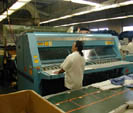Hospitals eTool
Laundry » Noise Exposure
Hazards

Occupational exposure to high noise levels from loud machinery in the laundry area can lead to occupationally-induced hearing loss, hearing impairment, hypertension, elevated blood pressure levels and other health hazards.
Requirements under OSHA's Occupational Noise Exposure Standard, 29 CFR 1910.95
OSHA's Occupational Noise Exposure Standard [29 CFR 1910.95] for general industry (which includes the healthcare sector) requires employers to implement a Hearing Conservation Program for all workers who are exposed to an 8-hour time-weighted average (TWA) noise level of 85 decibels (dBA) or higher. A Hearing Conservation Program must include, for example, requirements for measuring employee noise exposure levels, making available annual hearing tests and PPE (i.e., hearing protectors) at no cost to workers, and providing training.
Engineering and administrative controls are the first line of defense against excessive noise exposure (i.e., exposure above the standard's Permissible Noise Exposure Level). Hearing protectors, such as earmuffs and plugs, must be worn when engineering and administrative controls are not feasible to reduce noise levels below the standard's Permissible Noise Exposure Level. See Table G-16 in 29 CFR 1910.95 for more information on that standard's Permissible Noise Exposure requirements. In addition, hearing protectors must be worn by a worker exposed to an 8-hour time-weighted average noise level of at least 85 dBA, when the worker's hearing tests indicate significant hearing damage (relative to the baseline hearing tests required by the standard) or the worker has not yet had the baseline hearing tests required by the standard.
Additional Information
- Occupational Noise Exposure. OSHA Safety and Health Topics Page.
- Also see Hospital-wide Hazards - Noise Exposure.

